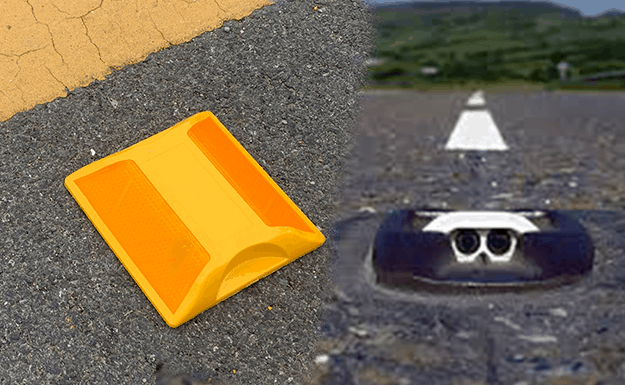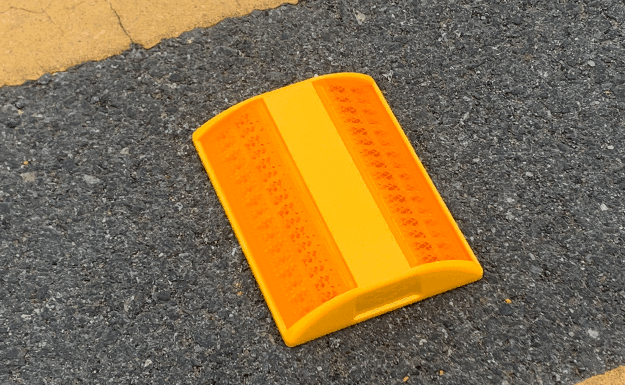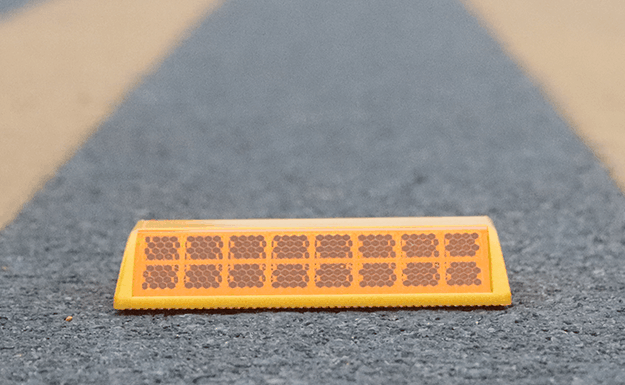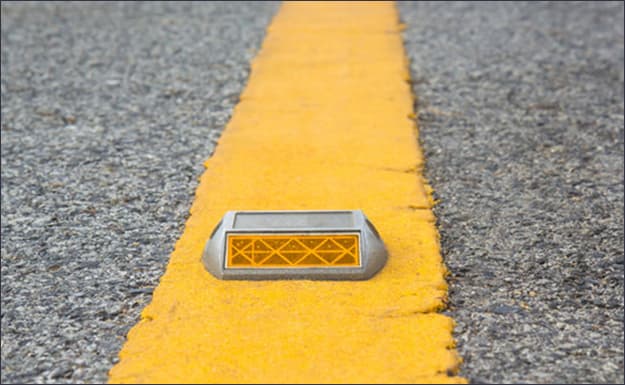Road stud and cat-eye road studs are indispensable and important equipment in highway traffic. They play a vital role in ensuring traffic safety, optimizing road design and improving driving experience. Although road stud and cat-eye road stud have similar names and have a lot of functional overlap, they have significant differences in their construction, materials, installation locations, and specific applications. This article will explore in detail the differences between road studs and cat-eye road studs to better understand their role in road traffic and the basis for their selection.
1. Definition and functions of road studs
Road studs, also known as
reflective road studs, are a type of traffic facility installed on the road surface and are mainly used for road markings and lane separation. Road studs are typically made from a hard, durable material such as cast iron, plastic, or ceramic, and are covered with reflective material. These reflective materials can reflect vehicle lights at night or in conditions of low visibility, thereby helping drivers to clarify lane boundaries and improving driving safety.
The main functions of road studs include:
Lane separation:
Road studs are often used to mark lane lines, especially at night or in conditions of low visibility such as rain and fog. They can clearly reflect the boundaries of the lane, prevent vehicles from deviating from the lane, and avoid traffic accidents.
Deceleration reminder: In some road sections where deceleration is required, such as near schools, sharp bends or in front of intersections, road studs can remind drivers to slow down through their raised shapes.
Navigation guidance: Road studs are sometimes installed on the centerline or edge of the road to help drivers maintain the correct direction at night or in bad weather.
2. Definition and function of cat's eye road studs
Cat eye road studs, as the name suggests, look and function like a cat's eye. The design of cat eye road studs is inspired by the ability of cat eyes to reflect light at night. Cat-eye road studs are usually equipped with a type of reflector or optical glass that reflects the light from the vehicle's headlights back into the driver's field of vision, making them stand out in the dark.
The main functions of cat eye road studs include:
Reflective enhancement: Cat-eye road studs can reflect the light of vehicle headlights, helping drivers see road signs more clearly at night or in low-visibility conditions, especially on roads without street lights.
Durability: Cat-eye spikes are typically made from high-strength materials that can withstand repeated crushing by heavy vehicles while maintaining their reflective properties.
Guidance function: Cat-eye road studs are often installed on the center line of the road, lane dividers or road edges to guide vehicles to drive in the correct lane, especially on complex road sections with obstructed vision, such as mountain roads or tunnels.
3. The main differences between road studs and cat eye road studs
Although road studs and cat eye road studs have many similarities in function, they have the following key differences in structure, materials, use environment, etc.:
Reflective mechanisms are different:
Road studs: Reflective coatings or
reflective sheets are usually used to achieve the reflective effect. The reflective intensity depends on the incident angle of the light and the performance of the reflective material.
Cat Eye Road Stud: Built-in reflective lens or optical glass, which can reflect light more concentratedly and effectively. Since the reflective device inside the cat eye road stud is optically designed, its reflective effect is particularly noticeable at night or in low-visibility conditions.
Structure and design:
Road studs: Relatively simple designs, usually flat or slightly raised structures that are easy to install and maintain. Road studs come in various shapes, including square, round or rectangular, and are mainly selected based on the type of road and application scenario.
Cat Eye Road Stud: A more complex design, usually containing multiple reflectors or lenses and a convex shape. This design not only enhances its reflective properties but also increases its durability in harsh conditions.
Materials and Durability:
Road studs: Mostly made of metal, plastic or ceramic materials, they have high strength and wear resistance and can adapt to different types of road conditions. However, the reflective material of ordinary road studs can gradually fail over time, especially under the pressure of frequent traffic.
Cat Eye Road Stud: Made of high-strength metal or glass, especially the internal reflective device is usually made of high-quality optical glass or special materials, which has a longer service life and greater durability. Cat's eye road studs can still maintain their reflective properties after being exposed to the natural environment for a long time.
Application scenarios:
Road studs: widely used in urban roads, highways, parking lots and other places, mainly play the role of marking and separating lanes. Road studs are commonly used on flat roads and are suitable for areas with dense traffic.
Cat-eye road studs: usually used in road environments with low visibility, such as at night, foggy days or unlit roads, especially on suburban roads, mountain roads, tunnels or temporary construction sections, where their reflective effect is extremely important. In addition, cat-eye road studs are also widely used on highways and high-risk road sections to improve driver attention.
4. Choose appropriate road studs or cat eye road studs
When choosing road studs or
cat eye road studs, there are several factors to consider, including road environment, traffic volume, maintenance needs and cost. Here are some suggestions for selection:
Road environment: If it is in urban areas or on roads with heavy traffic, ordinary road studs can already meet most marking needs; but in rural areas or on roads with low visibility, the high reflective performance of cat eye road studs is more suitable.
Durability requirements: For applications that require long-term durability, such as highways or areas prone to severe weather,
cat eye road studs are often a better choice due to their material and structural advantages.
Installation and maintenance costs: The cost of ordinary road studs is relatively low, suitable for large-scale applications, and maintenance is relatively simple. Due to its complex structure and high cost, cat eye road studs are usually used in scenarios with higher requirements.
Traffic safety requirements: On roads with a high risk of traffic accidents or dangerous roads with limited visibility, priority should be given to the use of cat eye road studs to enhance safety at night and in bad weather.
5. Summary
As an important part of
road traffic facilities, road studs and cat eye road studs play an important role in ensuring driving safety and guiding traffic flow. They each have their own characteristics and are suitable for different road environments and usage scenarios. By understanding the differences between road studs and cat eye road stud, traffic engineers and planners can better select and apply these devices to make road traffic safer and more efficient.
Whether on busy urban roads or remote mountain roads,
road studs and cat eye road studs provide drivers with important visual guidance and safety. With the continuous development of transportation technology, it is believed that these road facilities will continue to be optimized and upgraded to protect the public's travel.
Different Types of Road Studs
Road studs can be classified by material:
Aluminum road studs: pressure-resistant, durable, suitable for heavy-loaded vehicles. Suitable for highways and main roads with heavy traffic.
Plastic road studs: low price, light weight, suitable for low-traffic areas. Suitable for parking lots, campus internal roads, etc.
Glass road studs: high reflective performance, beautiful, suitable for decorative scenes. Mostly used for landscape roads and sidewalks.



